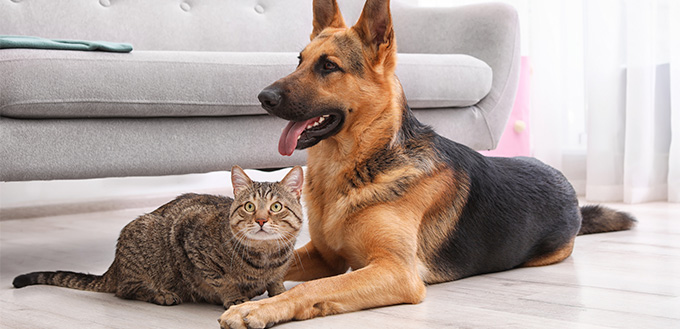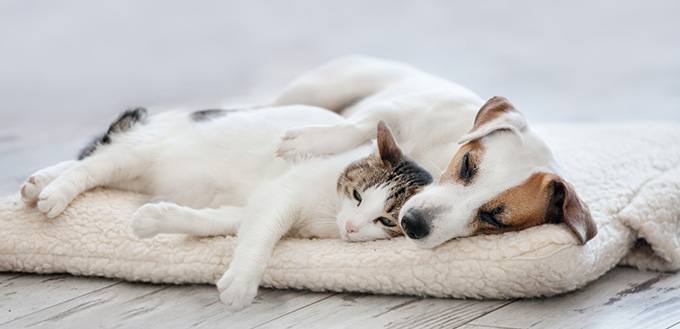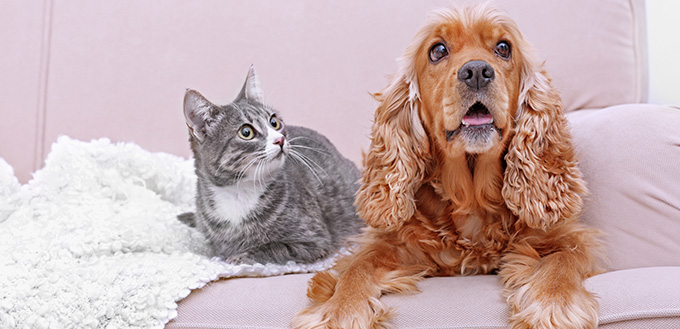Can cats live peacefully alongside dogs? The answer to the above question is in the affirmative. But then, pet parents should do well in taking their time, and following some set rules for introducing pups to kitties – there is no good reason the canines and felines cannot develop a harmonious co-existence with each other. However, we should never trust them to work out things without human intervention, as the introduction can be dangerous in some situations.
Even in situations where a dog has had previous interactions with cats or the cat has been exposed to dogs in the past, you still have to proceed with caution at the introduction stage. Recommendations are that you have someone else on the scene, so as to intervene with either of the animals, if and when the need arises. If the household happens to have more than one pup, it is best to introduce each of the dogs separately to the feline. Now, let’s get into the stages of introducing cats and dogs. Below are the different methods that can be used.

Read The Body Language Of Both The Cat And Dog
If the talk is on how to make cats and dogs get along, pet parents should watch the body language of both kitty and pup. A very apt indicator that your cat is not pleased is when you observe the back and forth swishing movement in its tail, or when you see the ears pinned back. Dogs also exhibit some body language indicating displeasure – it might become completely focused on the feline by staring, stiffening, and may resort to whining or barking.
Once these signs are evident, please don’t allow your dog to go near the cat. The ideal body language that will make you know all is well is when you observe that your pet dog is loose and relaxed in the company of the feline. It is quite fine if the pup pays attention to the kitty, but the red flag is when it becomes fixated on the cat.
In addition to that, cats and dogs getting along in a household may change, but this is dependent on the environment they find themselves in. Just because your canine companion is now interacting well with the cat inside the confinement of the home is not a guarantee that similar behavior will be exhibited when both happen to be in a different location – like when they move outside. Your dog might change and fixate on the kitty, and eventually start stalking it in the great outdoors. In order to get on top of the situation, you as the pet parent should take note of both animal’s body language in different situations, until you see that they have totally acclimatized to each other given any condition.
Gradual Desensitization
We have seen the first method on how to introduce a cat to a dog; however, if the first technique you try did not work out, or maybe you feel that it is not ok, you can go ahead and take a different option. Upon the observation that your canine friend is too fixated on the feline, you have to give a trial to desensitization – here; the aim is to reduce the pup’s reaction to the kitty by slowly and steadily increasing their exposure to each other.
Confine the cat in a spare room equipped with some kind of high baby gate across the entrance. The room should be one that the pup will not be able to access, and has no need of accessing. For instance, you shouldn’t choose your bedroom if your canine companion sleeps in there with you every night. The idea behind this is to keep both house pets separated, but in a situation where they will be able to view each other at specific periods.
Equip Them With Supplies
In the cat’s room, provide all needed supplies like cat toys, litter box (you may want to consider a dog-proof litter box), food as well as water. You have to take note of the fact that the felines are quite adept at squeezing themselves through any small gap, and are also competent jumpers and climbers; ensure that the gate you construct is high enough to deter your cat from jumping or climbing over. The pet gate functions as a barrier permitting both animals to view each other at a safe distance but never access themselves.
For the desensitization to work properly, allow your dog to view the cat briefly and then get the dog’s attention on to something else like practicing cues or even playing with toys. Recommendations are that the dog is leashed so that it will be easy to move it out of the cat’s way when the need arises. Lavish praises and rewards on your pup for being able to focus its attention elsewhere. Continue with the process all through the day.
More often than not, merely sighting the cat might be a bit too exciting for the pup. When that happens to be the case, shut the connecting door and commence feeding each of them on their own sides of the door – the dog eats its meal in its room close to the connecting door, while the cat does the same on the other side of the door. This situation allows both to associate the scent of each other with something good (food). Some pet parents have tried swapping the beddings of the two pets – this way, the cat gets familiar with the dog’s smell and vice versa. This will be achieved without overstimulating either of them.
With hope, this process of slow and steady introduction between both animals will get them accustomed to each other’s presence; eventually, the pup will become desensitized, losing interest in the kitty in the process. This feat has been achieved in a couple of hours in some cases; however, it may take days, weeks, or perhaps months – you just need to be patient. Each cat and dog represent distinct individuals and will learn at their own pace.
There are still situations where dogs have never relented enough to safely share their space with any member of the feline population. Under such conditions where you don’t trust the pup enough to let it loose around the cat – please keep both of them separated. Dogs have been known to maim or kill cats very fast; besides, the cat is not likely to leave the dog without inflicting injuries. Ensuring that both household pets are safe should be your top priority.

Face-To-Face Introduction
This method of introduction is more fast-paced – the pup should be held on a loose lead by someone who would also watch its body language. A second person should take charge of watching the feline’s body language. If it happens that the cat is not hissing around the pup with its back raised, then it is safe to allow it to move freely around the canine. It is quite rare to see a cat that poses a threat to a dog; however, some felines quickly go on the offensive when exposed to dogs.
If you observe that the pup is calm around the kitty, you can go ahead to ask your dog to lie down, sit, or stay, if the dog has previously learned those cues. Meanwhile, the cat should be allowed to move about freely, and can even sniff the dog if it wants. If the dog manages to ignore the cat, then it should be rewarded and praised. On the other hand, if the vibes are negative, maybe the dog becomes fixated, exhibits stiff body language, won’t listen to your voice, or tries to pounce on the cat, then, you should try a different approach.
‘ Look at That’
When the quick approach fails, and the dog is not getting desensitized to the kitty, there may be a need for more structured training. This can be achieved through playing LAT (Look at That) with your canine friend – this aids in teaching is not to be fixated on the kitty. The idea is to teach the dog to look at the feline, and then turn its attention back to you for a reward. The essence is for the pup to know that it is more rewarding to occasionally look away from the kitty.
Before commencing LAT, there is a need to figure out the threshold of the pup while leashed: At what point does the canine notice the kitty, but still, answer to you upon mentioning its name? That is exactly the dog’s threshold. Each member of the canine population has different thresholds. For a pup, the threshold might turn out to be five feet away from the kitty; however, the story may be different for another dog whose own threshold might be as much as twenty-five feet. To know when you have violated the threshold, the dog might begin barking at the kitty or making lunges at it. Another sign that the gap is too close is if the dog begins to move more slowly, staring as well as stiffening its body. If it fails to respond to your call, move a distance away from the feline.
Once the dog’s threshold is figured out, get a hold of a training clicker and some dog treats. In the absence of a clicker, some verbal markers such as good or yes will suffice. Put a good number of treats in your hand while keeping the bag handy for later.
When you notice the pup’s attention on the dog, activate the clicker or your verbal marker, and then follow up with a reward. Initially, you may need to put the reward in front of your pooch’s nose, but with time, the dog will start looking at you expectantly upon hearing the sound of your voice or the clicker – this is because, it has associated the sound with a treat, use as much as 10 treats, and click immediately the dog’s attention moves to the cat.
On the 11th round, hold on with the clicker, and observe if your dog will glance at the feline, and then look back at you. If that is the case, use the verbal marker or click, then reward the dog with a treat. If that is not the case, you have to move back a step. Mark the pup ten more times for looking at the kitty, and give it another try. Upon being secure in the knowledge that the trick is working, you can commence a low movement towards the cat. If it happens that the dog becomes fixated on the kitty at a closer distance – that means you have exceeded the threshold and must move back.
The threshold is expected to decrease with constant training, and you should continue to move the two animals closer to each other. The LAT process should continue until both cat and dog can cohabit in proximity without issues. How fast the threshold decreases is dependent on the pet parent (the frequency of practice and the rewards used), the dog (since each dog has their different paces of learning), and the kitty’s comfort level.

How To Introduce A Puppy To A Cat
It can be very easy to introduce puppies to grown cats since a cat that is well socialized might be ok with the natural behaviors of a puppy. However, if the puppy is the type that would not hesitate to give the shy cat a chase, then, it is up to you to halt the situation. You will have to keep their interactions under check until such a time that the puppy becomes old enough to control itself, and has undergone some necessary training. You wouldn’t want to engender a situation where your puppy imbibes the habit of chasing the kitty around the house and think it is fun. You can leverage baby gates to keep both household pets safe and apart. You may decide to leash the puppy, to keep the situation under control. By so doing, you can easily redirect the puppy in case it starts chasing after the feline.
Sources:
- Introducing Dogs to Cats, American Humane
- Wendy C. Fries, When Dog and Cat Meet, WebMD
- Pauline Gill, How to Train Dogs and Cats to Live Together, The Nest
- 5 Steps To Successfully Introducing Your Cat To A New Pet, VCA Hospitals
- Sherry Woodard, How to Introduce a Dog to a Cat, Best Friends Animal Society
Note: The advice provided in this post is intended for informational purposes and does not constitute medical advice regarding pets. For an accurate diagnosis of your pet's condition, please make an appointment with your vet.





